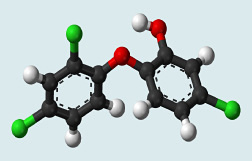This page has been archived and is being provided for reference purposes only. The page is no longer being updated, and therefore, links on the page may be invalid.
|
Read the magazine story to find out more. |
|
|
|
|
New Test Speeds Triclosan Detection in Water
By Jan SuszkiwJanuary 9, 2009
A new test for detecting triclosan should expedite environmental monitoring of the antibacterial agent in rivers, wells and other water sources, according to studies by Agricultural Research Service (ARS) and collaborating scientists.
Triclosan's widespread use in household products—from hand soaps and toothpaste to socks and pet shampoos—has led to debate over the chemical's impact on the environment, wildlife, human health and antimicrobial resistance. Existing methods of gathering information on triclosan and its metabolites in the environment are costly to use, require dedicated lab space and necessitate specialized training, according Weilin Shelver.
Shelver, a chemist in the ARS Animal Metabolism-Agricultural Chemicals Research Unit in Fargo, N.D., developed the new triclosan test in collaboration with Jennifer Church, Lisa Kamp and Fernando Rubio, a research team at Abraxis, Inc., of Warminster, Pa.
The new test, called a magnetic particle enzyme immunoassay, isn't intended to replace the gas chromatography-mass spectrometry (GC-MS) methods now used, but rather complement them, especially for routine monitoring of tricolosan in a large number of water samples.
The team evaluated the test by using it to detect triclosan and its derivative, methyl-triclosan, in river water, tap water and sewage samples from three municipal plants in the Red River Basin area shared by North Dakota and Minnesota. River and tap water analyses revealed triclosan and methyl-triclosan levels below 20 parts per trillion (ppt), indicating little contamination of the rivers that supplied the samples.
The team's wastewater analysis showed that, before treatment, triclosan levels sometimes exceeded 3,000 ppt, but after treatment, those levels fell below 500 ppt. According to Shelver, the results confirmed other reports indicating that sewage plants' purification steps removed much, but not all, of the triclosan from water before it is discharged into the environment.
In addition to correlating well with GC-MS analysis during the study's validation phase, the new test proved sensitive enough to distinguish triclosan from chemically similar contaminants.
Read more about this research in the January 2009 issue of Agricultural Research magazine.
ARS is a scientific research agency of the U.S. Department of Agriculture.


